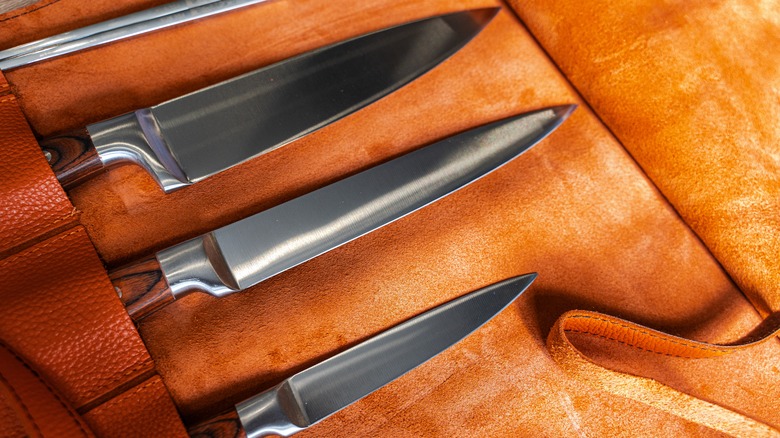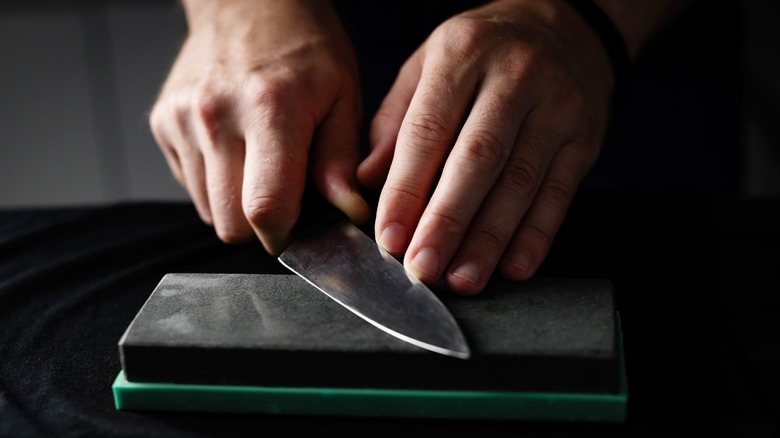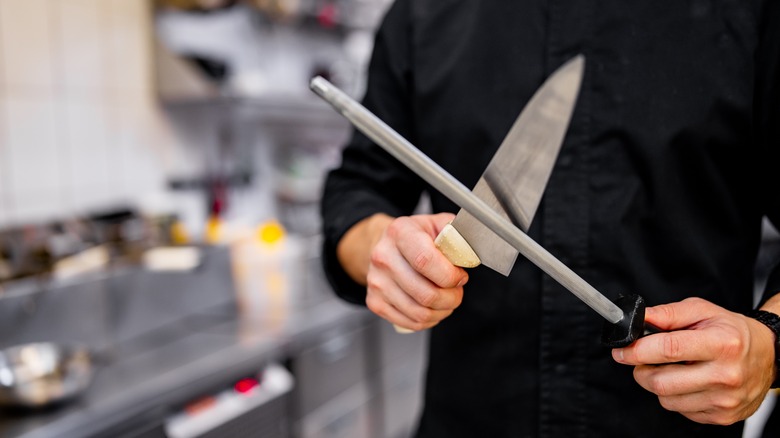The Big Difference Between Sharpening Japanese And German Styled Knives
Japanese and German knives are lauded by both professional chefs and home cooks alike as some of the best in the world for their craftsmanship, durability, and cutting precision. You may recognize some of the more popular brands like Wüsthof, Zwilling J.A. Henckels, Masamoto, Misono, and Shun. But the two blade types are very different.
Japanese knives are typically hand-honed and hand-refined. They feature thin, straight, and sharp blades that excel at precise slicing, trimming, and mincing. These tools derive directly from the famed samurai sword and can cut things with just a gentle graze. While they are harder — they're made with steel that has a high carbon content — they're also more prone to chipping. German knives, on the other hand, are often regarded as the "workhorses" of the kitchen. Heavier than their Japanese counterparts, they have curved blades designed for rocking cuts. They are versatile and can be used when more force is required, such as cutting bones and joints. In sum, Japanese knives are prized for their sharpness, German knives for their strength.
Practicing proper knife maintenance is important for optimizing their efficiency and lifespan. Due to their differences, Japanese and German knives require distinct care and sharpening techniques. The latter, in particular, involves differences in whetstone grit and sharpening angle.
Two distinct sharpening techniques
Sharpening is an important aspect of knife maintenance. While some professionals offer this service, you can do it yourself using a sharpening stone, also known as a whetstone. They're made from various materials and have different grit levels — lower numbers indicate the stone has larger abrasive particles. Coarser sharpening stones have grit levels between 100 and 1,000. They remove the most metal when used and are best for repairing chips or sharpening a very dull blade. On the other hand, fine sharpening stones, with a grit level of at least 4,000, give your knife a razor-like edge.
The main differences between sharpening Japanese and German knives are the stone's grit size and the angle at which the knife should be sharpened. Japanese models require a finer grit sharpening stone of at least 1,000 to keep their edge and remove as little material as possible. Due to their small cutting angle, they should be sharpened at an angle of 10 to 15 degrees. German knives, on the other hand, require a coarse sharpening stone of no more than 800 grit at an angle of 20 to 22 degrees. How often you need to sharpen your blades depends on how frequently you use them. But because German knives are made with softer steel, they will likely need to be sharpened more often.
Other essential tools for knife maintenance
In addition to a sharpening stone, a honing steel is an essential part of maintaining a German-style knife. This long, rod-like tool is not intended for whetting but for straightening and realigning the blade's edge, correcting any nicks or bends. It should be used roughly every 20 to 30 minutes when cutting. This process helps restore the blade's performance and ensures smoother, more precise cuts. However, honing steel should not be used on Japanese-style knives as their edges are too fine and it could result in chipping.
A regular part of knife maintenance that is frequently overlooked is oiling the blade. The viscous liquid forms a protective barrier, preventing patination and corrosion. Experts recommend using food-grade mineral oil and applying it with a designated towel (do not use cooking oils). Lastly, be mindful of how you store your knives — don't just throw them in a drawer. Consider using edge guards, which will help the blades maintain their sharpness and reduce your risk of cutting yourself. Other recommended options include magnetic strips, leather knife rolls, and knife blocks.


